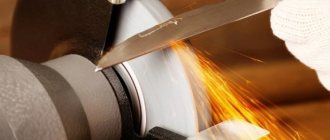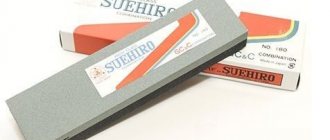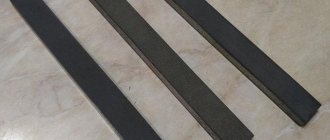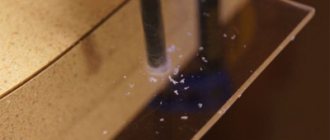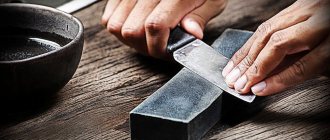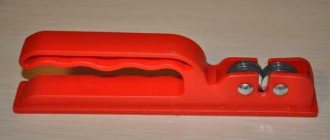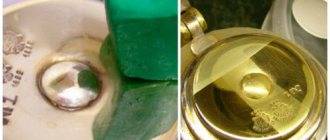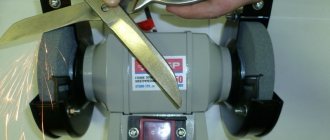We all constantly use a tool such as a knife, at least for cooking. In many occupations and professions, the knife is also used for other operations. And, of course, for normal operation it must be sharp.
But not everyone knows how to give the cutting edge that same razor sharpness or, at worst, the ability to cleanly cut the required material. After all, in order to sharpen a blade, you must first decide on a sharpening tool.
Why a whetstone?
In order to restore lost sharpness to knives (or give it to them for the first time), there are many devices. There are hand-held sharpeners made up of several abrasive discs, and electric devices, even large sharpening machines that are used in enterprises.
For obvious reasons, you won’t keep bulky equipment at home. As for manual sharpeners, their big disadvantage is the inability to set the sharpening angle, as well as the fact that the blade runs along the working part, which leads to accelerated wear of the knife. In addition, such sharpening does not last long.
Unlike previous options, a sharpening stone (or whetstone) gives the owner of the knife a certain freedom of action, for example, choosing the angle at which the cutting edge will be processed.
If you reach a certain level of skill, then with the help of a set of sharpening stones you can bring the knife to the state that craftsmen demonstrate in the video: shaving, cutting hair on the fly, or cutting off the transparent layers from a tomato without holding it with your hands.
What size to choose a water stone and how to care for it
The issue of area and thickness of the stones is also important. It is generally accepted that geometrically large stones belong to the “professional” series. This is partly true, because. With regular use, water stones wear out quickly and they must have a significant margin of thickness. By the way, any water stones, due to their susceptibility to wear, require periodic editing using a special device. Caring for water stones actually consists of properly straightening them into a flat state, chamfering them along the edges to avoid chipping along the edges, washing them, drying them after work, and storing them carefully. It is also important to have the correct equipment for the workplace - a sufficient area of the table, sufficient lighting, a good base for the stone if it is sold without a stand, and a container for soaking the stones of adequate size.
For home use, you should select the size of the stones depending on how often you will sharpen knives and what sizes of knives are present in your set. The area of the sharpening stones should be commensurate with the size of the blades. So, if the largest knife in your set has a blade length of 20-26 cm, then stones of size 210x70 mm are logical for sharpening. In turn, for knives no larger than 15 cm, stones 170x50mm as stone are sufficient. The most commonly used stones should be purchased thicker. For example, an excellent option for a long-lasting stone is Naniwa IE-1400. Finishing stones are rarely thick because... less subject to wear and tear and quite expensive.
What else is worth saying about Japanese water stones? There are a lot of good things, but this is exactly what follows: if you have never been able to quickly sharpen a knife to razor sharpness, water stones are the shortest path to success. If your knife is difficult to sharpen and the steel is too hard, take a water sharpener, it will sharpen everything. If your knife literally becomes dull just by looking at it, buy a modest water gun and everything will change for the better.
Vladimir Sokolovich,
sharpening master of the Basselard chain of stores
Philip de Lew is a knifemaker from Belgium who became widely known thanks to a joint project with Spyderco.
In the recent past, we got acquainted with the first joint work of the master, namely the model of the Filip De Leeuw's Friction Folder knife.
Types and selection criteria
Sharpening bars vary greatly in properties and price. What suits the housewife in the home kitchen may not suit the knife collector who wants to achieve excellent results with outstanding examples. But that’s the beauty of sharpening stones: everyone can choose a product to suit their needs and wallet.
Natural sharpening stones
People had to sharpen knives, weapons and agricultural implements long before industry began producing sharpening stones. Initially, the tools were stones of suitable shape and structure, with a smooth and slightly rough surface. Even today, after half an hour of searching, an experienced tourist will find a cobblestone in the scattering, which will significantly improve the cutting characteristics of a dull blade.
Natural sharpening stones produced by various companies have the same origin. Since the end of the 18th century, they have been mined in special deposits. Large blanks cut and carved into rocks are cut to the required sizes, after which they are given a perfect geometric shape already in production conditions.
The main characteristic of a natural sharpening stone that makes it valuable is its chemical composition and physical characteristics. For proper operation, it is necessary that the source material contains the necessary inclusion of solid particles of a certain size.
In the modern market, well-known brands of such stones are quite expensive - primarily as a result of the marketing policies of companies. Searching for new deposits of raw materials for natural sharpening stones and their subsequent processing is a very expensive process; it is much cheaper to produce artificial materials with the desired characteristics. Those companies that have a history and production experience present their products as a brand, making a good profit.
However, the sharpening and cutting properties of natural stones are really good. By selecting products of different grain sizes, you can achieve impressive results. In addition, good natural material is quite resistant, wears out and wears out slowly. With careful use it will serve the owner for many years.
Known variants
There are several deposits from which the company receives raw materials for the production of finished sharpening stones of natural origin.
"Arkansas". Received its name from the location of the mine workings in the USA. Arkansas stone is the mineral novaculite. It is rarely found in nature, which led to its high price. It consists of no less than 97% silicon oxide, while the crystals are very small in size, which allows the use of Arkansas stones for finishing and grinding. Arkansas stone bars are produced by different manufacturers. Users can also find the name "Washita".
An entire culture has developed around Arkansas whetstones. On the Internet there is a trade in samples that were made back in the 19th century. Accordingly, their price is very high. You can also find information that at the moment all the quarries in which raw materials were extracted are already closed, hence the high cost. It is quite difficult to verify this, but novaculite stones continue to be produced to this day.
Arkansas stone varies in grain size and degree of abrasive effect. Sometimes manufacturers designate this by color (gray, black), in other cases - by a general verbal marking (“Hard”, “Truehard”). The instructions for Arkansas blades recommend using oil when sharpening, which, however, does not prevent users from using water.
Artificial
Industrial production has made it possible to obtain abrasive bars with the required parameters of hardness, grain size and abrasion resistance. They come in different brands, are made from specific raw materials, and vary greatly in cost. For example, in a hardware store you can easily find a product for 100 rubles, which sometimes may not even have packaging. Such a block, even after careful culling, can only be used to set the angle of the cutting edge.
Famous manufacturers produce high-quality synthetic bars that are no cheaper than natural Arkansas bars. The reason is the homogeneity of the structure, strictly observed hardness parameters, uniform wear, the absence of burrs and chips when processing the knife.
Expert opinion
Levin Dmitry Konstantinovich
Synthetic sharpening stones are produced using similar technology. The basis is an abrasive powder with a certain particle size (it determines the future grain size). Microgranules are held together using a binder (for example, Bakelite or other plastics). The resulting viscous mixture is pressed into molds, when not only the pressure but also the temperature increases. As a result, the composition seems to sinter and has good hardness indicators, although in terms of fragility it is significantly inferior to natural stones.
Emery (abrasive)
The most famous and frequently used. They can be produced as single products with a specified grain size, or in the form of sets, usually including two or three stones - for coarser and finer sharpening, as well as for finishing. Another way to increase the versatility of the stone is a double-sided design: during the manufacturing process, two portions of a mass of abrasives with different characteristics are sintered longitudinally.
Various high-hardness substances are used as the main composition: electrocorundum, artificial diamonds, CBN, chromium oxide, various silicates. The price and quality range of such stones is very wide. Japanese water stones, made under the careful supervision of experienced craftsmen, can cost several thousand rubles.
Most emery stones require the use of water during the sharpening process. The bar is either completely immersed in water to soak for 5 - 10 minutes, or periodically sprayed as it dries. Wetting promotes the formation of an emulsion of particles of the bar, water and removed metal at the point of contact between the blade and the abrasive layer. This makes the processing more subtle and prevents the formation of creases and chips.
Diamond
It is often a metal base, on which a thin coating of a mixture of synthetic diamond chips or powder with the addition of other abrasives is applied on one or both sides. Such stones are quite expensive, but they provide consistent results even with knives made of high-hardness carbon steel.
True, no less often you can find sharpening stones in which the place of diamond is, at best, taken by borazon. This makes them significantly cheaper, but offers almost no advantages over sanding blocks.
Ceramic
Ceramics are clay and its derivatives that have undergone heat treatment. Technologies make it possible to produce ceramic sharpening stones with minimal grain size. It is notable for its low cost, but at the same time it regularly aligns the cutting edge of knives made of different steels.
A significant part of ceramic bars, due to their relative softness and smooth surface texture, are used not so much for sharpening as for straightening knives. The most suitable area of application is working with stainless steel kitchen knives.
Unlike other materials, ceramics are often shaped not like a bar, but into another shape: a tube, a thin cylinder. Such sharpeners are used both independently and as part of sharpening kits.
Bottom line
The most recommended sharpeners for household (kitchen) knives are water-based. In addition to the order of magnitude superior speed of the process (relative to other types), these stones provide delicate processing of the cutting tool. It is important to consider the material of the knife. If the device is made of metals that are vulnerable to rust, it is worth considering other types of sharpeners. When using a non-water-based type of stone, sharpening will take longer, but the knife blade (not resistant to corrosion) will last longer.
Speaking about the grit of stone for household knives, it is recommended to consider specimens with an indicator of 1500 grit or more. A large fraction can damage the integrity of the blade, especially with frequent use.
The sharpener should be maintained taking into account the characteristics of the type of stone:
- The water type implies the presence of a vinyl box. These boxes prevent moisture evaporation, which has a beneficial effect on such sharpeners. It is also unacceptable to contain waterstone at low temperatures. If you break this rule, the stone will certainly burst.
- It is recommended to keep sharpeners of other types in conditions that prevent excessive formation of dust. A box that closes securely is suitable for this. If such a sharpener becomes contaminated with dust, the particles will become clogged and the tool will lose effectiveness. It is not recommended to allow the stone to come into contact with other surfaces; before placing it in the box, it is necessary to wrap the tool in paper. Wrapping in a cloth napkin is also allowed.
The modern market offers an abundance of sharpening stones; it is not uncommon for an inexperienced user to be at a loss when choosing. In order not to make a rash purchase, it is necessary to take into account the parameters of the grit and material of manufacture, as well as the form factor of the product and dimensions. Stones with a strong reputation will last an impressive period of time if the user does not neglect the basic rules for maintaining the sharpener.
Grain
The most important parameter that determines the nature of work with a sharpening stone. The larger the granules included in the bar, the more metal it will remove in one pass of the blade across the surface. Accordingly, finishing stones are almost smooth to the touch - tactile sensations simply do not provide information about the size of the grains.
What type of sharpening stone do you have at home?
NaturalArtificial
The grit measurement scale differs in countries that produce knife sharpening materials. Thus, in the USSR the size in microns was adopted, which, however, is still used today as an equivalent. But Western manufacturers use a system of conventional units called grit, that is, the degree of roughness. This quantity is dimensionless.
The general rule is this: the lower the grit value, the larger the particles and rougher processing await the owner of the knife. Large values of several thousand grit indicate finishing, grinding and even polishing stones.
Today there are several standards in force:
- FEPA (for European manufacturers of sharpening stones);
- JIS (Japanese products are labeled according to it);
- ANSI (adopted in the USA and applies to American products).
Expert opinion
Levin Dmitry Konstantinovich
Grit roughness values are not exact values and values may vary among different standards. Therefore, you need to purchase a stone for a knife based on your experience and needs, trying different options.
Question answer
How to clean the bar when it gets dirty?
Under running water using a not very hard brush. Many people wipe off traces of the suspension after drying with a regular eraser.
What else can you sharpen and trim stones besides knives?
Relatively speaking, everything that is less hard and preferably plastic (metal): scissors, chisels, manicure tools, axes, scythes and sickles (if you are making a film about the harvest in pre-revolutionary Russia).
What oil should I use when sharpening with Arkansas?
In general, this is not important, since any oil will give the desired effect. Considering that knives can be used for cooking, you can take edible vegetable oil - olive, linseed. For tourist and technical knives, a spindle or ballistol is better suited.
Using a stone to sharpen knives indicates that a person loves knives and does not mind spending a few minutes (or tens of minutes) on sharpening and finishing. Well, a good sharpening stone pays its owner with good results.
Preparation for sharpening
So, we figured out the essence of the stone itself. Now let's talk about how we can prepare for sharpening.
A water stone is a water stone because it requires working in a moist state, i.e., it requires soaking. We will need ordinary clean water and a wide, comfortable bowl where we will place the stone. If it has large grains, it will quickly become saturated with water, since the cavities between the grains will be large. Stones with fine grains tend to have a higher density and will sit in water for a long time and release air bubbles. It is the cessation of the appearance of bubbles that will tell us that the stone is ready for sharpening. Therefore, it is good if the container is transparent: this way we can better monitor the disappearance of air bubbles and the readiness of the stone for work. It is advisable that different containers be used for stones of different grain sizes. Then large particles separated with the suspension will not clog the cavities in fine-grained stones.
While the stone is soaking, prepare the work surface and get ready for sharpening. First of all, remember that you should be comfortable. Remove everything unnecessary from the table, lay out a rubber sheet on the surface or, even better, install a special holder for a water stone. This is not an idle whim: the stone must be firmly fixed during sharpening. But with a new stone, carefully round the side edges with another stone - if your hand trembles, they can damage the sharpening. If you have already moved on to finishing, then apply the suspension to the surface with a soft stone - a piece of Nagura, for example.
Now take a look at the knife and visually divide it into several segments - usually from three to five, in areas that differ in bend; this is the heel, belly, instep, part near the tip. You can, of course, sharpen “in one fell swoop,” but you will have to, firstly, constantly change the pressure (otherwise you will remove more metal closer to the tip), and secondly, change the line of movement and the angle of the blade. Rational Japanese are supporters of segmental sharpening. They visually endow each segment with a perpendicular line and guide the knife along it during sharpening.
If you only have a “bare” stone without a device that both holds the stone and fixes the desired sharpening angle, you can get a simpler device - a shaped clamp that is attached to the butt and prevents it from being raised or lowered more than it should. Or press a small coin to the butt, using its position relative to the surface of the stone to track a constant angle.
It is most convenient to acquire a device that will fix both the stone itself and a constant specified sharpening angle.
